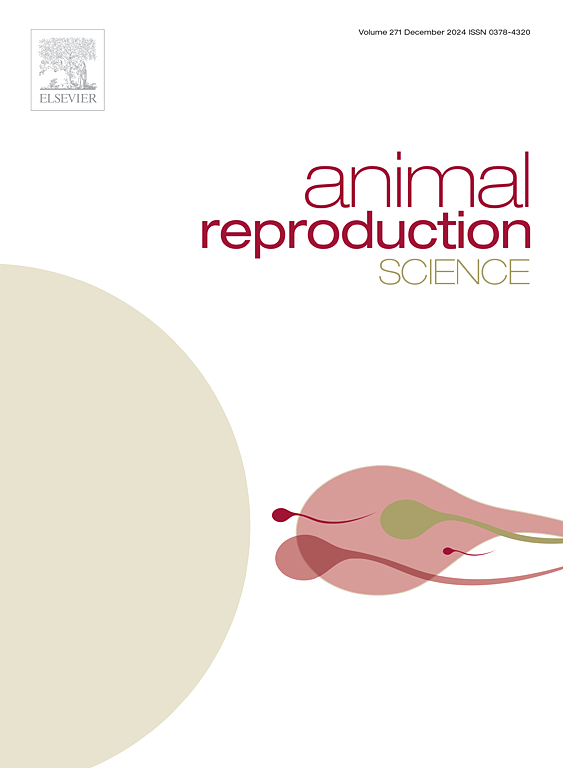水体pH和温度对印度泥鳅繁殖和胚胎发育的影响
IF 2.2
2区 农林科学
Q1 AGRICULTURE, DAIRY & ANIMAL SCIENCE
引用次数: 0
摘要
印度棘泥鳅(Lepidocephalichthys thermalis)是泥鳅科和小型本地物种(SIS)的一员,由于其生态适应性和养殖潜力,是印度水产养殖部门多样化的新兴候选物种。然而,泥鳅的圈养繁殖和商业种子生产方案仍未探索。因此,本试验旨在研究水体pH和温度对热乳杆菌自然产卵和胚胎发育的影响。该研究进行了两个不同的实验,在第一个实验中,鱼在三种不同的pH值下释放,如6.0-6.5 (T1), 7.0-7.5 (T2)和8.0-8.5 (T3),为期60天。泥鳅鱼平均体长- 5.77 ± 0.11 cm,平均体重- 0.78 ± 0.06 g,雌雄比例为1:2,共设9个实验槽(容水量- 48 L)放养。这三个pH值的治疗,显著提高(P & lt; 0.05)产卵率(1047.0 ±71.33 鸡蛋/ g的女性),受精率(86.66 ±6.42 %)和孵化率(79.86 ±5.57 %)获得在T2治疗组显示更好的繁殖性能的鱼。此外,T2处理组还记录了泥鳅鱼的胚胎发育情况。在热刺激实验中,泥鳅鱼保持在26 °C的恒定水温下,并于第15天和第30天分别暴露在T1(25 °C)、T2(24 °C)、T3(23 °C)和T4(22 °C)四种不同的水温下。在试验期间,不同处理暴露的鱼没有记录到繁殖活动的迹象。然而,在热刺激实验中,对卵母细胞的组织学分析记录了5个不同的卵母细胞成熟阶段,即染色质核期(CNS)、核周期(PS)、卵黄形成期(VS)、成熟卵(RE)和水合卵母细胞(HYO)。此外,研究发现T4组和T2组的最终配子成熟率分别显著高于(63.24 ± 4.26 %)和低于(27.05 ± 2.14 %)。综上所述,7.0 ~ 7.5的pH值更适合泥鳅成功圈养产卵。另一方面,温度控制(将水温从26 °C突然降低到22 °C)显著提高了圈养条件下热鲤的最终配子成熟。这些发现为通过圈养种子生产将其纳入印度水产养殖多样化战略提供了有价值的见解,也为该物种在野生条件下的保护提供了有希望的解决方案。本文章由计算机程序翻译,如有差异,请以英文原文为准。
Influence of water pH and temperature on breeding and embryo development of Indian spiny loach (Lepidocephalichthys thermalis)
The Indian spiny loach (Lepidocephalichthys thermalis), a member of the Cobitidae family and small indigenous species (SIS), is an emerging candidate species for diversification in the Indian aquaculture sector due to its ecological adaptability and culture potential. However, the captive breeding and seed production protocols for commercial seed production of loach fish remain unexplored. Therefore, the present experiment was aimed at studying the effects of water pH and temperature manipulation on the natural spawning and embryonic development of L. thermalis. The study carried out two different experiments and in the first experiment, fish was released in three different pH regimes such as 6.0–6.5 (T1), 7.0–7.5 (T2), and 8.0–8.5 (T3) for a period of 60 days. A total of 9 experimental troughs (water holding capacity – 48 L) were used to stock the loach fish (average length - 5.77 ± 0.11 cm, average weight - 0.78 ± 0.06 g) at 1:2 sex ratio (female: male). Out of these three pH treatments, significantly higher (P < 0.05) spawning rate (1047.0 ± 71.33 eggs/g of female), fertilization rate (86.66 ± 6.42 %) and hatching rate (79.86 ± 5.57 %) were obtained in T2 treatment group which indicated better breeding performance of fish in that group. Further, the loach fish embryonic development was also recorded in T2 treatment group bred fish. In the thermal stimulation experiment, loach fish was kept at a constant water temperature of 26 °C and the fish were exposed to four different water temperatures such as T1 (25 °C), T2 (24 °C), T3 (23 °C) and T4 (22 °C) on 15th and 30th days. During this trial, no sign of breeding activity was recorded in different treatment exposed fish. However, the histological analysis of oocytes documented five different oocyte maturity stages such as chromatin nucleus stage (CNS), perinucleus stage (PS), vitellogenic stage (VS), ripening egg (RE), and hydrated oocytes (HYO) during the thermal stimulation experiment. Further, the study found significantly higher (63.24 ± 4.26 %) and lower (27.05 ± 2.14 %) final gamete maturation rates in T4 and T2 groups exposed fish, respectively. Based on the above results, it can be concluded that the pH of 7.0–7.5 is more suitable for successful captive spawning of loach fish. On the other side, temperature manipulation (sudden reduction of water temperature from 26 °C to 22 °C) had significantly improved the final gamete maturation of L. thermalis fish under captivity. These findings provide valuable insights for its inclusion in India’s aquaculture diversification strategies through captive seed production and also provide a promising solution for this species conservation at wild conditions.
求助全文
通过发布文献求助,成功后即可免费获取论文全文。
去求助
来源期刊

Animal Reproduction Science
农林科学-奶制品与动物科学
CiteScore
4.50
自引率
9.10%
发文量
136
审稿时长
54 days
期刊介绍:
Animal Reproduction Science publishes results from studies relating to reproduction and fertility in animals. This includes both fundamental research and applied studies, including management practices that increase our understanding of the biology and manipulation of reproduction. Manuscripts should go into depth in the mechanisms involved in the research reported, rather than a give a mere description of findings. The focus is on animals that are useful to humans including food- and fibre-producing; companion/recreational; captive; and endangered species including zoo animals, but excluding laboratory animals unless the results of the study provide new information that impacts the basic understanding of the biology or manipulation of reproduction.
The journal''s scope includes the study of reproductive physiology and endocrinology, reproductive cycles, natural and artificial control of reproduction, preservation and use of gametes and embryos, pregnancy and parturition, infertility and sterility, diagnostic and therapeutic techniques.
The Editorial Board of Animal Reproduction Science has decided not to publish papers in which there is an exclusive examination of the in vitro development of oocytes and embryos; however, there will be consideration of papers that include in vitro studies where the source of the oocytes and/or development of the embryos beyond the blastocyst stage is part of the experimental design.
 求助内容:
求助内容: 应助结果提醒方式:
应助结果提醒方式:


